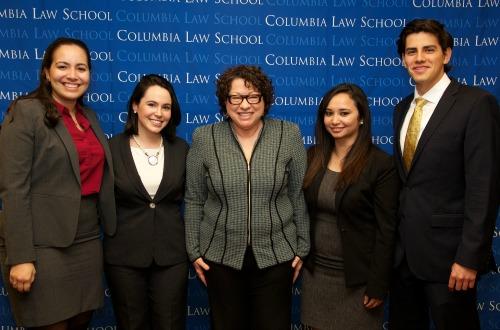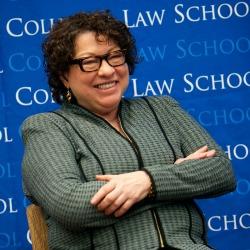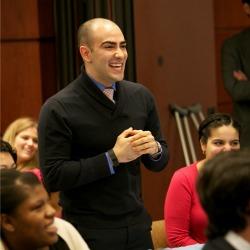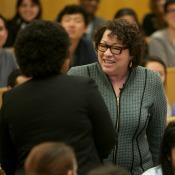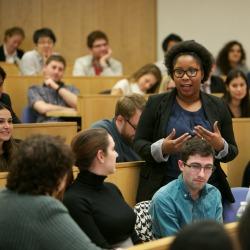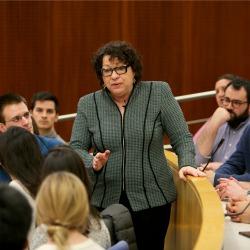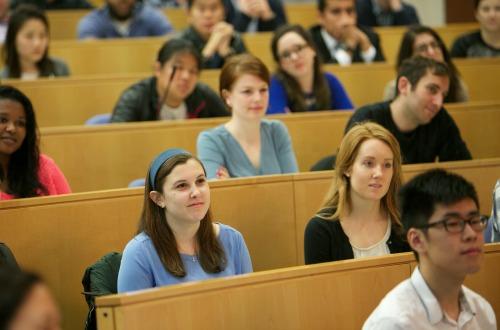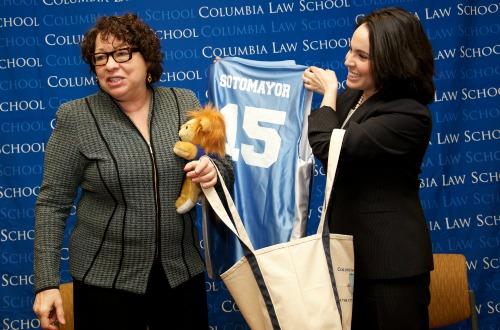A Supreme Encounter
U.S. Supreme Court Justice Sonia Sotomayor Talked to Columbia Law School Students About Her Role on the Court, Her Experiences as a Latina in the Legal Profession, and the Legacy She Hopes to Leave Behind
April 28, 2015—Long before she was appointed to the U.S. Supreme Court, Sonia Sotomayor was a lecturer at Columbia Law School, where she created and co-taught the Federal Appellate Court Externship.
The Bronx-born Sotomayor returned to Morningside Heights April 10 at the invitation of the Latino/a Law Students Association and captivated students and faculty members alike in a series of expansive question-and-answer sessions.
| Members of the 2013-2014 LaLSA board invited U.S. Supreme Court Justice Sonia Sotomayor to speak at Columbia Law School. "We've had this date circled on our calendar for months," former LaLSA Vice President Joseph S. Guzman '15, far right, told the justice when he introduced her at the LaLSA gathering. From left, former Social Chair Zila R. Acosta '15, former Banquet Chair Ana Carolina Varela '15, and former President Mayra B. Joachin '15 served as moderators for Sotomayor's discussions throughout the day. |
Sharing Her Perspective
The justice reflected on everything from her experiences as a woman of color, the most formative moments of her career, and her dissent in the 2014 Schuette affirmative action case to the colleague whose writing style she most admires: Justice Ruth Bader Ginsburg ’59.
Sotomayor spent almost a full day at Columbia Law School, joining faculty for lunch, meeting with LaLSA members, and engaging with nearly 200 LL.M. and first-, second-, and third-year students in a larger forum. She spoke candidly, warmly, and with humor, completely at ease among both her former colleagues and the future attorneys who may one day make an appearance before her court. In sessions with students, Sotomayor crisscrossed the room, shaking hands, doling out hugs, and posing for pictures.
“This is the greatest thing that’s ever happened to me,” said one student, after receiving an embrace.
|
|
Sotomayor smiles in a rare seated moment during her visit to campus. LaLSA President Luis G. Hoyos '16, center, asks a question during the justice's meeting with LaLSA students. At right, Sotomayor greets a student in her session with the larger student group. |
‘A Voice in the Room’
Sotomayor took several questions on her 2014 dissent in Schuette v. Coalition to Defend Affirmative Action, in which the majority upheld a Michigan ballot initiative that prohibited the use of race-based preferences as part of the admissions process for state universities. She wrote, in part:
“Race matters to a young man’s view of society when he spends his teenage years watching others tense up as he passes, no matter the neighborhood where he grew up. Race matters to a young woman’s sense of self when she states her hometown, and then is pressed, “No, where are you really from?”, regardless of how many generations her family has been in the country. Race matters to a young person addressed by a stranger in a foreign language, which he does not understand because only English was spoken at home. Race matters because of the slights, the snickers, the silent judgments that reinforce that most crippling of thoughts: “I do not belong here.”
Shortly after the case was decided, U.S. Attorney General Eric H. Holder, Jr. ’76 called the dissent “courageous,” and a New Republic piece said it marked the day Sotomayor “really arrived on the court.”
Sotomayor referenced the case in response to a question about the most challenging part of her job, which she said was living with the knowledge that the justices’ answer on an issue might be the final answer.
“I had not understood how burdensome it would be to be on a court of last resort,” she said.
The Schuette dissent—joined by Ginsburg—was about “being a voice in the room,” she said. “I could understand the ‘why’ in that case because I’ve lived it—that’s the value of having people with different experiences on the court.”
| Top left, a student poses a question for Sotomayor, who momentarily took a seat to give the questioner the floor. The justice made her way in and out of aisles during her talk to connect with students, who gave her their undivided attention no matter where she was in the room. |
Personal Legacy
Answering questions about her own career path, Sotomayor offered students this advice: Do what you love and do it well.
“There are not that many fatal decisions in life except for doing something you don’t like to do,” she said. “If you’re looking for jobs to pay off student loans only, that’s a recipe for catastrophe. Sacrifice is not something that should scare you away from doing what you want to do.”
Sotomayor’s affection for students was palpable throughout the day, and the feeling was decidedly mutual. During her meeting with LaLSA, after a heartfelt welcome from Joseph S. Guzmán ’15, the justice conversed in both Spanish and English and reminisced about her own experiences as a Latina at Yale Law School. Later, Ana Carolina Varela ’15 and Zila R. Acosta ’15 presented Sotomayor with some Columbia Law School memorabilia.
| Varela presents Sotomayor with a Columbia Lion in a t-shirt emblazoned with "Sotomaroar," a Deans' Cup jersey, and a Columbia Law School tote bag. "Oh, I love these," the justice said of the bag. "I use them to carry my cert petitions." |
Sotomayor said she makes a conscious effort to connect with people—law students, lawyers, and otherwise. Answering a question about her legacy, she said she can’t control the cases that come before her. What she can control, she said, is her level of engagement with society, the extent to which she tries to impress upon people the importance of the court’s work. She is one of the more public-facing justices, with appearances on “The Daily Show with Jon Stewart” and “Sesame Street,” for example, plus periodic stops at community centers and Head Start programs across the country.
“That’s something meaningful,” she said. “Then my legacy will live as long as anyone who has been affected by me lives.”
When Sotomayor finally left Jerome Greene Hall Room 104—running out the clock on her scheduled visit after waving off an earlier attempt to wrap up the Q&A out of respect for her schedule—the students were still resonant with the energy she had left behind.
